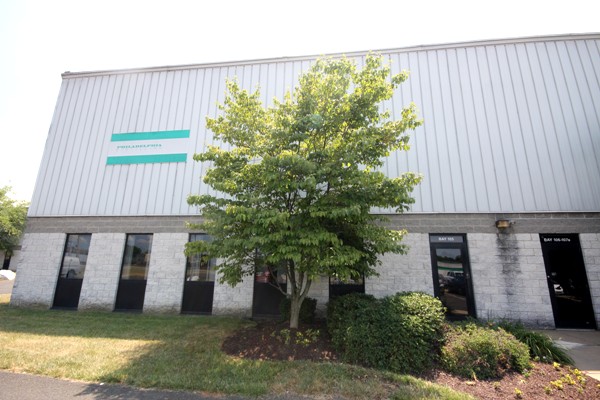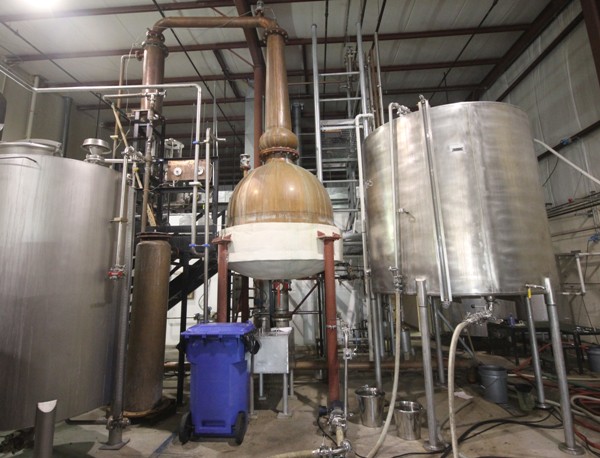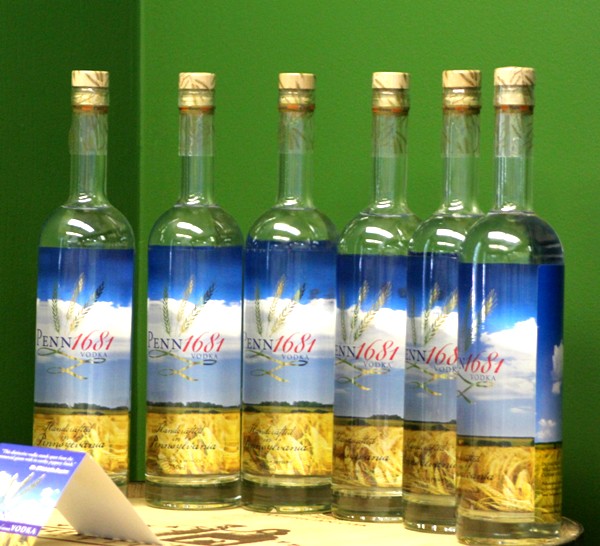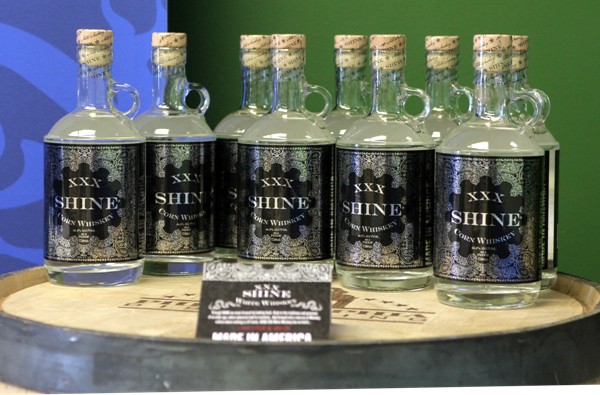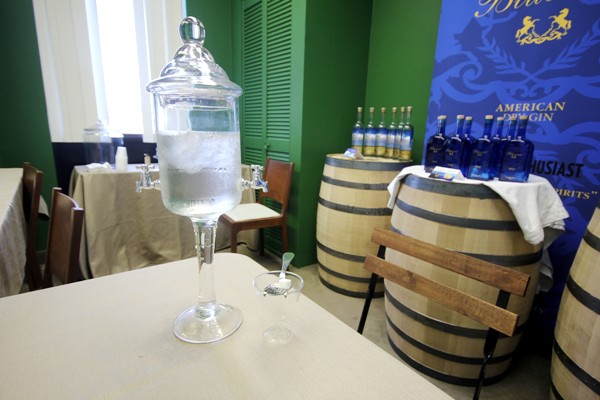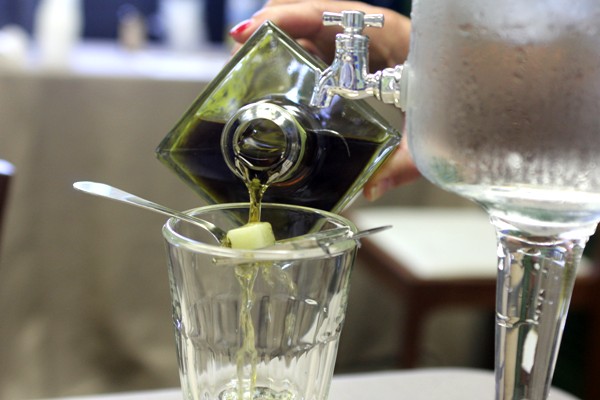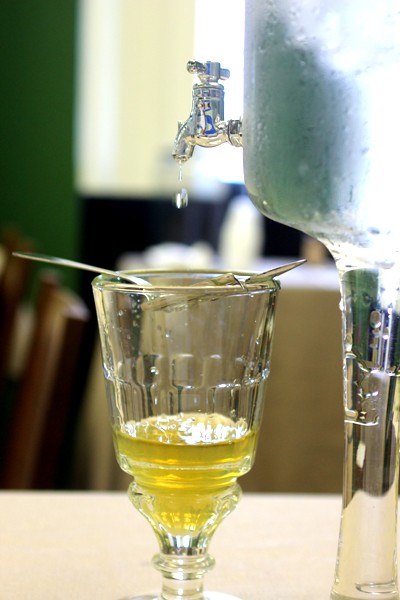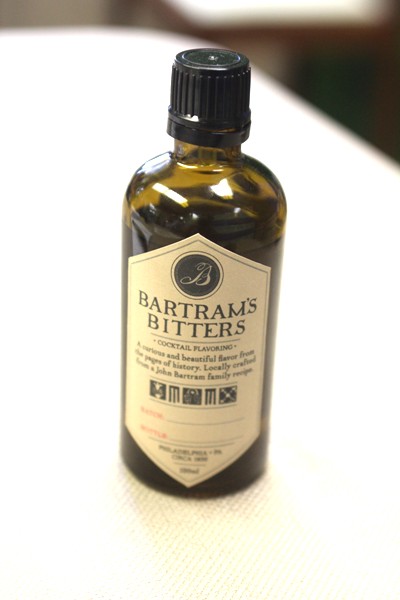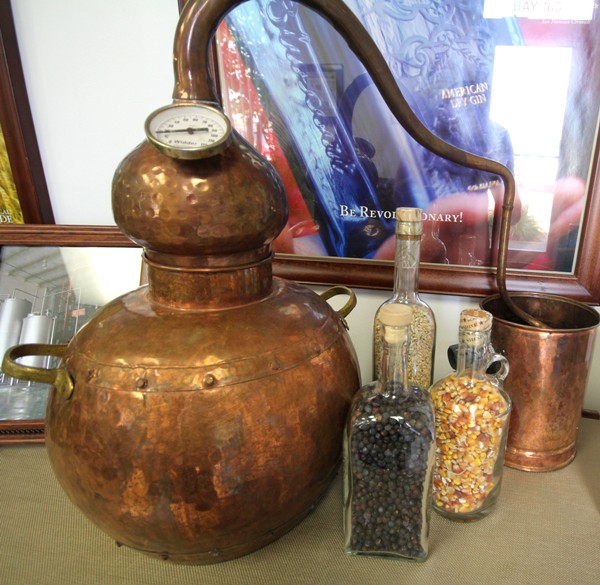A couple weeks ago we took a jaunt down the turnpike to visit Philadelphia Distilling, creators and purveyors of our favorite gin, Bluecoat, among other alcoholic wonders.
We were graciously toured around the facility and guided through a tasting of products by Meredith Maciolek, the company’s Pennsylvania account executive. For how ubiquitous Bluecoat gin seems to have become, not to mention their other liquors, it was a bit surprising to find out how small their operation is. Tucked inside of an industrial park in Northeast Philly, one could easily drive right past the distillery (like we did) without ever knowing it was there.
In the back area the distilling, packaging, and warehousing all occurs within the same big garage space. The biggest and most eye-catching thing is the looming Forsyths copper pot still that dominates the room. Behind it is a column still that the company uses to make their Penn 1681 vodka. As we’re standing there gawking over what turns rotgut into magic a guy zips around wildly on a forklift. Pallets filled with Bluecoat bottles dot the space and large stainless steel totes filled with fermenting corn mash are stacked along the wall. There’s a couple wooden barrels high up on a barrel rack, but more about those later.
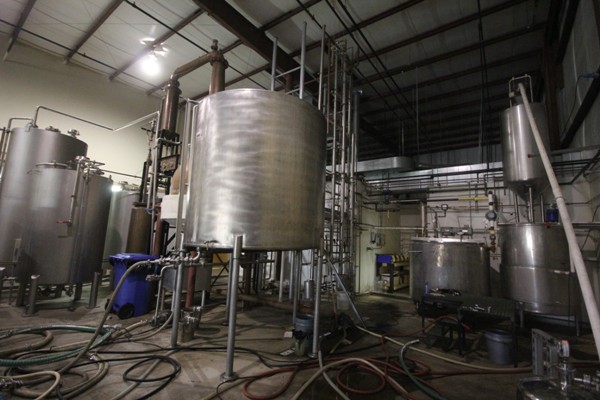
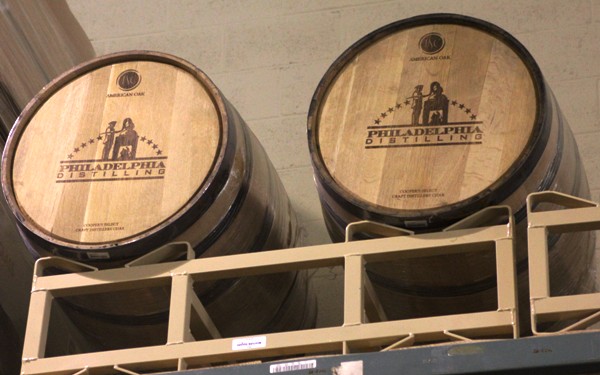
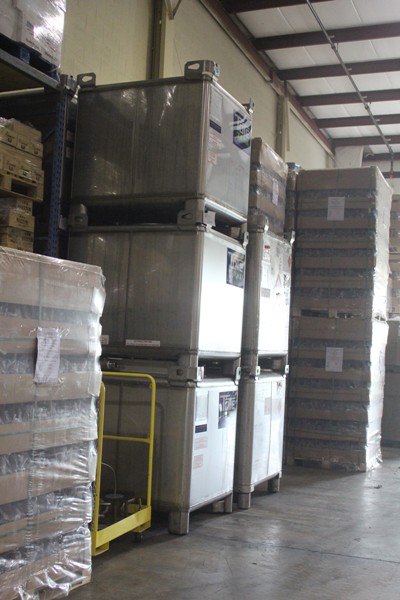
Ms. Maciolek leads us back into a room with a spread of booze to try out. First up is a Bluecoat vs. Tanqueray comparing and contrasting session. Bluecoat utilizes organic juniper berries which differ from the traditional ones used in London Dry Gin. The difference in the two is striking – the organic ones are far more aromatic. They also add in Angelica Root, a plant that emits a smooth, musky odor. The company calls Bluecoat an American Dry Gin, a new class of booze that aims to set them apart from their London counterparts.
Upon tasting the two gins the difference in these two examples is evident: the Tanqueray is what people think of when they think gin. Pine. Christmas tree. Juniper out the ass. Then there’s Bluecoat. Bluecoat is hugely citrusy, owing to the Sweet Valencia orange and lemon peels the company sources from California and Florida. The contrast between the two is huge, and trying them side-by-side was a revelation. It made one think, “Why haven’t I tried this before?”
Next up was the vodka. Philadelphia Distilling’s Penn 1681 vodka is made from Pennsylvania-sourced rye, some of it from our own Lehigh County. We tried the Penn vodka up against Absolut. They were both fine. There’s not too much else for us to say other than that as they were, to us, not too distinguishable from each other in both taste and smoothness.
And so it was on to Shine, Philadelphia Distilling’s shot at a white whiskey. White whiskey is all the rage with small distilleries these days because it adds another spirit in their arsenal that doesn’t have to be aged in barrels over the course of months, years, or decades. It provides a quicker turnover of cash return and doesn’t require nearly as much space as barreled whiskey does. Most distillers these days are doing some sort of name or shtick based on moonshine. Real moonshine was and is terrible, unrefined, unaged, and far, far high in alcohol content than Shine’s 44.4%. Today’s white whiskeys are for more palatable than moonshine, but that doesn’t stop the companies from using the moonshine gimmick.
Philadelphia Distilling is no exception. Using “shine” right in the name they promote it as a hard-edged, “no bullshit” product. We’re not particularly fond of whiskey that doesn’t spend at least a few years in barrels, but for what it is, Shine isn’t terrible. It’s a 100% corn mash that utilizes three different types of corn: yellow #2, Jersey white, and an heirloom variety from upstate New York.
Ms. Maciolek mentioned an interesting take on Shine: use it as a tequila substitute. Manhattans and Old Fashioneds demand an aged whiskey and just wouldn’t taste right with such a corny (there’s 3/4 to 1 acre worth in each bottle) product that doesn’t have the complexity that barrels lend to whiskey, despite what the recipes on the Shine site would have you believe. With the vegetal character coming through heavily as it does in good tequila, this is the most interesting and well-thought use for this product we otherwise found unremarkable, if drinkable. A “moonshine margarita” doesn’t sound bad at all after giving Shine a taste.
And the finisher was none other than Philly’s own take on Absinthe, that misunderstood, oft-fabled beverage that was only recently made legal in the United States. Vieux Carre utilizes hyssop, lemon balm, green anise, petite wormwood, and genepi, a type of alpine wormwood. Not a big fan of anise/black licorice flavor, we approached this one carefully. It was prepared with a traditional absinthe fountain. The process was such: a slotted spoon with a cube of sugar on top was placed atop a glass and absinthe was poured over the sugar. Water was then slowly dripped onto the sugar, letting is dissolve and drop further down into the absinthe. The absinthe transformed into a milky green mixture, a process known as louching.
Now that the spirit was watered down from its high alcohol content and sweetened up a bit, it was ready to be consumed. The nose on this was intense and complex. You could just sit and smell this for an hour, picking out subtle notes and nuances that only absinthe can deliver. The taste was not terribly heavy on the anise and more or less lets a lot of the other herbal flavors come through. Quite a treat. And for the uninitiated to absinthe, the frou-frou custom of the slotted spoon, water, and sugar is certainly necessary. The last thing we drank was some Vieux straight up. Mistake.
So now that all of the tasting whatnot was out of the way, it was time to hear more about Philadelphia Distilling. In comes Robert Cassell, head distiller, owner, and the forklift operator extraordinaire we mentioned earlier. We discussed a huge variety of topics. It started off with him using distilling terms that sounded like the came from a graduate chemistry class after asking about yeast, but things eventually started making sense.
Besides going to college for nuclear medicine, Cassell used to work at Victory, as in Victory Brewing, the huge nationally-loved brewery nearby. He eventually decided he wanted to get into craft distilling because he believed it was going to blow up just as craft brewing did. Was he ever right. When Philadelphia Distilling began about six years ago there were 60 other distilleries in the United States. There are now over 250. Mr. Cassell shipped himself off to the Hariot-Watt International Centre for Brewing and Distilling, one of the most prestigious distilling programs in the world.
He started with the gin, and then added vodka, absinthe, and white whiskey to their line-up all in the course of six years. That’s pretty ballsy, especially considering the size of their place and their capacity constraints. So what’s next? They want to move into downtown Philadelphia and leave their tiny industrial park warehouse in the rearview mirror. Cassell has been instrumental in changing the face of the distilling scene in Pennsylvania, mostly because before him there wasn’t one.
Although a few distilleries operate in Pennsylvania (the most notable being Jacquin’s), no distillery had opened in PA since prohibition. When Cassell first went to apply for his distillery license the PLCB had to make up a form for him because none existed. When he went to get federally approved they told him he needed a still already in place. The catch? They never said how big. Cassell made a tiny pilot still, gauge included, that was completely functional and allowed him to get his approval. When he wanted to sell liquor at the distillery itself the PLCB said “nope, can’t do that.”
Some people think (and rightfully so) that the wine laws in this state are insane, and the beer ones are even worse. But it’s nothing compared to how distilleries are treated. Cassell lobbied – successfully – for fairness and common sense for distilleries. His testimony to the liquor control committee helped pave the way for distillery reform in Pennsylvania. The dream of moving downtown and getting a huge space with the ability to age spirits in barrels and have a proper tasting room for tourists is getting realer and realer.
Without Cassell the state of distilling of Pennsylvania would probably still be as stagnant as it was right after prohibition was lifted. Now newcomers, like Dad’s Hat, have the way paved for them to open up and provide tours and tastings (as Dad’s Hat recently began on July 14th).
Is that all the future holds? I inquired about those barrels I saw in the warehouse and Cassell simply smiled and said, “Ah, just fuckin’ around. Experiments.” Asked about anything new on the horizon, he didn’t give up if they were working on any new lines. We did, however, get to check out his Bartram’s Bitters. Only one 25 gallon batch has been made and recently released. It is based on a historical recipe that happened to fall out of a very old book and produced in conjunction with the historical Bartram’s Garden in Philly.
As we wrap up and say our goodbyes I think about just what Philadelphia Distilling might do in the future. Obviously aged whiskey is in Cassell’s plans, but what else? As we’re heading out the door I look at the barrels that greet visitors when they come in the front door and on one of them sits Cassell’s hilarious toy-sized pilot still. As I look it over I wonder if, just like that tiny still became the huge, beautiful Forsyths still in the main distilling room, are we going to witness Philadelphia Distilling itself transform from this tiny warehouse in the middle of nowhere North Philly into a huge facility downtown that has rows upon rows of barrels with visitors winding through on tours, samplers in-hand? Hopefully, and if Robert Cassell has his way, that day will come sooner than later.

